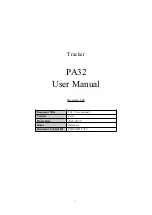
SHOUT nano User Guide Version A
Document Number: 451-92681-001A
52 of 60
A
PPENDIX
C:
P
OWER
C
ONSUMPTION
The SHOUT nano has an internal 1.95 Ah Lithium-ion (Li-ion) rechargeable battery. When both
the Iridium and GPS antennas have clear view of the sky and the battery is fully charged, the
SHOUT nano is capable of sending more than 1,500 tracking reports with the following settings:
(1) report rate of less than two hours, (2) mailbox check rate and the report rate are the same
and (3) Standard Accuracy. Blocked or partially blocked antennas will force the SHOUT nano to
retry multiple SBD transmissions for each report, and as a result can significantly reduce the
overall number of reporting cycles.
The SHOUT nano saves valid ephemeris data after each 3D fix. The data is used to reduce
acquisition time in the next reporting cycle from cold-start to hot-start. If the ephemeris data is
older than two hours (time between reports is set for more than two hours), the GPS receiver
will go through cold-start each time it wakes up to send a report. As a result, the SHOUT nano
configured for a report rate of more than two hours and Standard Accuracy can only send
approximately 750 tracking reports. Setting the Accuracy to Best also reduces the number of
tracking reports to approximately 750 regardless of the report rate setting.
IMPORTANT: Data presented here are only estimates and are highly dependent on the
operating environment, accuracy setting, and antenna type. Data are based on measurements
made with multiple SHOUT nano devices placed on the roof of NAL Research’s facility with no
blockage.
Each time the SHOUT nano wakes up to send a report, it has two minutes to acquire a GPS fix
and send an Iridium SBD message. Assuming the ephemeris data is valid (less than two hours
old or time-between-reports is less than two hours) and the Accuracy option is set to Standard,
the GPS receiver takes about 10 seconds for a position fix drawing approximately 55 mA. The
Iridium transceiver takes about 10 seconds to transmit an SBD message drawing an average
current of 110 mA. The SHOUT nano circuit draws about 125 mA during a 25-second reporting
cycle. The entire reporting cycle consumes approximately 1.32 mAh of battery power. If the
Iridium antenna is blocked or an overhead Iridium satellite is not available, the Iridium
transceiver can potentially stay on for another 100 seconds attempting to send a report. This









































